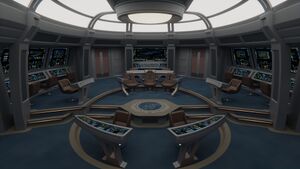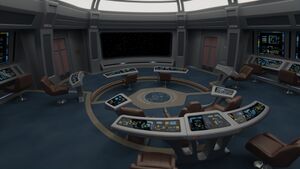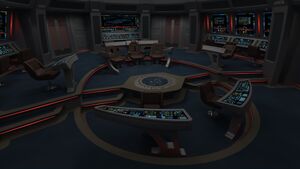USS Columbia: Difference between revisions
More actions
Removed a reference to Columbia sandbox |
mNo edit summary |
||
| Line 13: | Line 13: | ||
| destroyed = | | destroyed = | ||
| unit = | | unit = | ||
| taskforce =Task Force | | taskforce =Task Force 17 | ||
| taskgroup =Task Group | | taskgroup =Task Group 9 | ||
| division = Columbia Division | | division = Columbia Division | ||
| squadron = | | squadron = | ||
| Line 20: | Line 20: | ||
| homeport = | | homeport = | ||
| role = | | role = | ||
| co = [[bfms char: | | co = [[bfms char:145797|Captain Thalek th'Zorati]] | ||
| xo = [[bfms char: | | xo = [[bfms char:43421|Commander Noli Auru]] | ||
| dedication = [[file:ColumbiaPlaque.png]] | | dedication = [[file:ColumbiaPlaque.png]] | ||
}} | }} | ||
{{quote|Audentes fortuna juvat - Fortune favors the bold.|'''Vergil- ''Ship's Dedication Quote'''''}} | {{quote|Audentes fortuna juvat - Fortune favors the bold.|'''Vergil- ''Ship's Dedication Quote'''''}} | ||
'''USS ''Columbia'' (NCC-76991)''' is a [[Galaxy Class|''Galaxy-''class]] explorer assigned to the [[Fourth Fleet]] | '''USS ''Columbia'' (NCC-76991)''' is a [[Galaxy Class|''Galaxy-''class]] explorer assigned to the [[Fourth Fleet]]'s [[Task Force 17]], under the command of [[bfms char:145797|Captain Thalek th'Zorati]]. Having had a long, illustrious career, whether serving on the front lines of every major conflict since her construction or on the very frontier of explored space, ''Columbia'' is, to this day, one of the most prestigious assignments in the fleet. | ||
One of the six ''Galaxy''-class spaceframes constructed but not fully assembled during the initial production run of the class, ''Columbia'' was held in reserve for either a time of great need or to replace one of the original six production units. She ended up doing both, as her completion was ordered following the destruction of the USS ''Odyssey'' in the early 2370s. By the time the Dominion War broke out, her core systems, such as engines and weapons, were ready, but she was launched without the vast majority of her science labs and crew support systems. After serving as a battleship for the duration of the war, playing a crucial role in several key engagements, ''Columbia'' returned to dock in 2376 and was brought up to current exploratory standards. She entered service again in 2377 and has been a mainstay of the [[Fourth Fleet]]'s exploratory arm since. | |||
As of 2402, ''Columbia'' has been refit twice and remains a preeminent Starfleet exploratory platform. | |||
==Design and Layout== | |||
[[File:Proxima1.jpg|right|thumb|Main Bridge; command center for the USS ''Columbia'']] | |||
Consisting of an amalgamation of successful features from the [[Galaxy Class|Galaxy]] and [[Sovereign Class|Sovereign]] bridge modules of the 2360s and 70s, ''Columbia'' has been refit with one of the more unique bridge modules in the fleet. Importantly, it makes the most of a variety of technological advancements, such as holoprojectors, holographic communications, in-built weapons lockers and three-dimensional computer displays wherever logically possible. | |||
[[File: | |||
[[ | |||
[[ | |||
A unique design feature of the ''Columbia'' bridge module is the desire to have as many stations as possible facing a single focal point at the heart of the command center. This focal point is the United Federation of Planets logo proudly displayed on the carpeted deck plating, but this is not for purely decorative reasons. The logo actually serves as a holo-communications platform at the center of the bridge, making the most of innovative enhancements to display holoprojections from the LCARS database and holographic figures of people from lightyears away. Surrounding the holo-platform is the standard tri-seat command pit, with seats for the Captain, Executive Officer (starboard) and a third seat (port) reserved for any official or dignitary permitted on the bridge. Each seat has independent computer controls allowing access to a variety of ship systems. | |||
[[File:Proxima2.jpg|left|thumb|Forward view, including holocommunications platform]] | |||
Directly port and starboard of the command chairs are the inward-facing duty stations for tactical operations (port) and science (starboard). On the perimeter there are countless other additional stations designed to support mission operations. Behind the main science station on the starboard bulkhead, additional science and medical consoles are available, as well as access to life support. Adjacent to them on the starboard bulkhead, strategic operations, intelligence and security deployment stations are the focus. Directly behind the command chairs is a large console entirely configurable for the needs of any department, but with dedicated access to engineering functions if required, allowing the Chief Engineer (or any assigned officer) unparalleled access to engineering systems outside of the engineering bay itself. On the aft bulkhead, the obligatory Master Systems Display (MSD) serves as a fully customisable display, capable of hundreds of functions, including operating as a reduced viewscreen for mission operations. | |||
[[File: | |||
Directly ahead of the command pit, at the bottom of the ramp and between the commanding officer and the holographic viewscreen, two curved consoles serve as duty stations for Operations (port) and Flight Operations (starboard). | |||
[[File:Proxima3.jpg|right|thumb|Main bridge under red alert conditions]] | |||
Around the command center, four doors provide access to and from the bridge. On the forward port bulkhead, access is available to the commanding officer's ready room, and adjacent to it, the observation lounge and strategic operations suite. Aft of the bridge, both doors provide access to turbo lifts which enable the crew to access the command center from the rest of the bridge. Either may be overridden for priority access to key locations around the ship. | |||
Most notably, and a further move away from more recent trends, the bridge module is very well-lit, with the colours and tones in the room complimenting each other nicely and creating a warm aesthetic that is pleasing on the eye. During red alert, however, the bridge lights are dimmed and largely replaced by dozens of strip lights (visible along the floor and walls) that flash five times at the initial call for red alert, and then remain stationary until the alert is cancelled. | |||
==LCARS Database Articles== | |||
*''Main Article: [[Galaxy Class|Galaxy-class Explorer]]'' | |||
*''Main Article: [[User:Kai1701E/Columbia/Auxiliary Craft|Auxiliary craft assigned to ''Columbia'']] | |||
*''Main Article: [[User:Kai1701E/Columbia/Deck_Listing|A complete listing of all decks on ''Columbia'']] | |||
*''Main Article: [[User:Kai1701E/Columbia/Tour|A tour of key facilities around ''Columbia'']] | |||
<!-- Please do not delete the Notable Crew section as it is used for history tracking of the command --> | |||
====Notable | ==Commanding Officer Lineage== | ||
Notable commanding officers, past and present, include: | |||
*2400 - 2400: [[bfms_char:44744|Captain Noah Armstrong]] | *2400 - 2400: [[bfms_char:44744|Captain Noah Armstrong]] | ||
*2400 - 2402: Captain Romen Corbin | *2400 - 2402: Captain Romen Corbin | ||
Revision as of 22:31, 22 February 2025
- "Audentes fortuna juvat - Fortune favors the bold."
- —Vergil- Ship's Dedication Quote
USS Columbia (NCC-76991) is a Galaxy-class explorer assigned to the Fourth Fleet's Task Force 17, under the command of Captain Thalek th'Zorati. Having had a long, illustrious career, whether serving on the front lines of every major conflict since her construction or on the very frontier of explored space, Columbia is, to this day, one of the most prestigious assignments in the fleet.
One of the six Galaxy-class spaceframes constructed but not fully assembled during the initial production run of the class, Columbia was held in reserve for either a time of great need or to replace one of the original six production units. She ended up doing both, as her completion was ordered following the destruction of the USS Odyssey in the early 2370s. By the time the Dominion War broke out, her core systems, such as engines and weapons, were ready, but she was launched without the vast majority of her science labs and crew support systems. After serving as a battleship for the duration of the war, playing a crucial role in several key engagements, Columbia returned to dock in 2376 and was brought up to current exploratory standards. She entered service again in 2377 and has been a mainstay of the Fourth Fleet's exploratory arm since.
As of 2402, Columbia has been refit twice and remains a preeminent Starfleet exploratory platform.
Design and Layout

Consisting of an amalgamation of successful features from the Galaxy and Sovereign bridge modules of the 2360s and 70s, Columbia has been refit with one of the more unique bridge modules in the fleet. Importantly, it makes the most of a variety of technological advancements, such as holoprojectors, holographic communications, in-built weapons lockers and three-dimensional computer displays wherever logically possible.
A unique design feature of the Columbia bridge module is the desire to have as many stations as possible facing a single focal point at the heart of the command center. This focal point is the United Federation of Planets logo proudly displayed on the carpeted deck plating, but this is not for purely decorative reasons. The logo actually serves as a holo-communications platform at the center of the bridge, making the most of innovative enhancements to display holoprojections from the LCARS database and holographic figures of people from lightyears away. Surrounding the holo-platform is the standard tri-seat command pit, with seats for the Captain, Executive Officer (starboard) and a third seat (port) reserved for any official or dignitary permitted on the bridge. Each seat has independent computer controls allowing access to a variety of ship systems.

Directly port and starboard of the command chairs are the inward-facing duty stations for tactical operations (port) and science (starboard). On the perimeter there are countless other additional stations designed to support mission operations. Behind the main science station on the starboard bulkhead, additional science and medical consoles are available, as well as access to life support. Adjacent to them on the starboard bulkhead, strategic operations, intelligence and security deployment stations are the focus. Directly behind the command chairs is a large console entirely configurable for the needs of any department, but with dedicated access to engineering functions if required, allowing the Chief Engineer (or any assigned officer) unparalleled access to engineering systems outside of the engineering bay itself. On the aft bulkhead, the obligatory Master Systems Display (MSD) serves as a fully customisable display, capable of hundreds of functions, including operating as a reduced viewscreen for mission operations.
Directly ahead of the command pit, at the bottom of the ramp and between the commanding officer and the holographic viewscreen, two curved consoles serve as duty stations for Operations (port) and Flight Operations (starboard).

Around the command center, four doors provide access to and from the bridge. On the forward port bulkhead, access is available to the commanding officer's ready room, and adjacent to it, the observation lounge and strategic operations suite. Aft of the bridge, both doors provide access to turbo lifts which enable the crew to access the command center from the rest of the bridge. Either may be overridden for priority access to key locations around the ship.
Most notably, and a further move away from more recent trends, the bridge module is very well-lit, with the colours and tones in the room complimenting each other nicely and creating a warm aesthetic that is pleasing on the eye. During red alert, however, the bridge lights are dimmed and largely replaced by dozens of strip lights (visible along the floor and walls) that flash five times at the initial call for red alert, and then remain stationary until the alert is cancelled.
LCARS Database Articles
- Main Article: Galaxy-class Explorer
- Main Article: Auxiliary craft assigned to Columbia
- Main Article: A complete listing of all decks on Columbia
- Main Article: A tour of key facilities around Columbia
Commanding Officer Lineage
Notable commanding officers, past and present, include:
- 2400 - 2400: Captain Noah Armstrong
- 2400 - 2402: Captain Romen Corbin
- 2402 - Present: Captain Kelvan Vos
